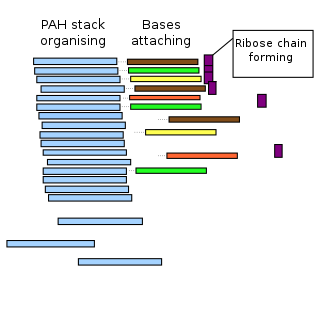The molecular formula C12H8 (molar mass: 152.19 g/mol, exact mass: 152.0626 u) may refer to:
- Acenaphthylene, a polycyclic aromatic hydrocarbon
- Biphenylene, an alternant, polycyclic hydrocarbon
The molecular formula C12H8 (molar mass: 152.19 g/mol, exact mass: 152.0626 u) may refer to:

Organic chemistry is a subdiscipline within chemistry involving the scientific study of the structure, properties, and reactions of organic compounds and organic materials, i.e., matter in its various forms that contain carbon atoms. Study of structure determines their structural formula. Study of properties includes physical and chemical properties, and evaluation of chemical reactivity to understand their behavior. The study of organic reactions includes the chemical synthesis of natural products, drugs, and polymers, and study of individual organic molecules in the laboratory and via theoretical study.

A polycyclic aromatic hydrocarbon (PAH) is a class of organic compounds that is composed of multiple aromatic rings. The simplest representative is naphthalene, having two aromatic rings and the three-ring compounds anthracene and phenanthrene. PAHs are uncharged, non-polar and planar. Many are colorless. Many of them are found in coal and in oil deposits, and are also produced by the combustion of organic matter—for example, in engines and incinerators or when biomass burns in forest fires.

In chemistry the term chicken wire is used in different contexts. Most of them relate to the similarity of the regular hexagonal (honeycomb-like) patterns found in certain chemical compounds to the mesh structure commonly seen in real chicken wire.

Triphenylene is an organic compound with the formula (C6H4)3. A flat polycyclic aromatic hydrocarbon (PAH), it consists of four fused benzene rings. Triphenylene has delocalized 18-π-electron systems based on a planar structure, corresponding to the symmetry group D3h. It is a white or colorless solid.

Perylene or perilene is a polycyclic aromatic hydrocarbon with the chemical formula C20H12, occurring as a brown solid. It or its derivatives may be carcinogenic, and it is considered to be a hazardous pollutant. In cell membrane cytochemistry, perylene is used as a fluorescent lipid probe. It is the parent compound of a class of rylene dyes.

Idrialite is a rare hydrocarbon mineral with approximate chemical formula C22H14.

The PAH world hypothesis is a speculative hypothesis that proposes that polycyclic aromatic hydrocarbons (PAHs), known to be abundant in the universe, including in comets, and assumed to be abundant in the primordial soup of the early Earth, played a major role in the origin of life by mediating the synthesis of RNA molecules, leading into the RNA world. However, as yet, the hypothesis is untested.
Polycyclic may refer to:

Chrysene is a polycyclic aromatic hydrocarbon (PAH) with the molecular formula C
18H
12 that consists of four fused benzene rings. It is a natural constituent of coal tar, from which it was first isolated and characterized. It is also found in creosote at levels of 0.5–6 mg/kg.
The molecular formula C5H12O5 (molar mass: 152.14 g/mol, exact mass: 152.068473 u) may refer to:
F number is a correlation number used in the analysis of polycyclic aromatic hydrocarbons (PAHs) as a descriptor of their hydrophobicity and molecular size. It was proposed by Robert Hurtubise and co-workers in 1977.
Iceane is a saturated polycyclic hydrocarbon with formula C12H18. It has a cage-like molecular structure, whose carbon skeleton can be viewed as three fused cyclohexane rings in the boat conformation; or as two such rings in the chair conformation, connected by three parallel (axial) bonds. The spatial arrangement of carbon atoms in Iceane is the lonsdalite crystalline structure.
The molecular formula C22H12 (molar mass: 276.33 g/mol, exact mass: 276.0939 u) may refer to:

Benzo[j]fluoranthene (BjF) is an organic compound with the chemical formula C20H12. Classified as a polycyclic aromatic hydrocarbon (PAH), it is a colourless solid that is poorly soluble in most solvents. Impure samples can appear off white. Closely related isomeric compounds include benzo[a]fluoranthene (BaF), bendo[b]fluoranthene (BbF), benzo[e]fluoranthene (BeF), and benzo[k]fluoranthene (BkF). BjF is present in fossil fuels and is released during incomplete combustion of organic matter. It has been traced in the smoke of cigarettes, exhaust from gasoline engines, emissions from the combustion of various types of coal and emissions from oil heating, as well as an impurity in some oils such as soybean oil.
The molecular formula C13H20 (molar mass: 224.32 g/mol) may refer to:
Gallaecimonas is a recently described genus of bacteria. The first described species of this genus was Gallaecimonas pentaromativorans gen. nov., sp. nov. isolated by Rodríguez Blanco et al. in 2010 from intertidal sediments of the ria of Corcubión. It is a Gram-negative, rod-shaped, halotolerant bacterium in the class Gammaproteobacteria. It can degrade high molecular mass polycyclic aromatic hydrocarbons of 4 and 5 rings. The 16S rRNA gene sequences of the type strain CEE_131(T) proved to be distantly related to those of Rheinheimera and Serratia. Its G+C content was 41.7 mol%.
Novosphingobium pentaromativorans is a species of high-molecular-mass polycyclic aromatic hydrocarbon-degrading bacterium. It is Gram-negative, yellow-pigmented and halophilic. With type strain US6-1T. Its genome has been sequenced.

Dibenzopyrenes are a group of high molecular weight polycyclic aromatic hydrocarbons with the molecular formula C24H14. There are five isomers of dibenzopyrene which differ by the arrangement of aromatic rings: dibenzo[a,e]pyrene, dibenzo[a,h]pyrene, dibenzo[a,i]pyrene, dibenzo[a,l]pyrene, and dibenzo[e,l]pyrene.
Benzofluorene or the molecular formula C17H12 may refer to:

Hypercubane is a hypothetical polycyclic hydrocarbon with the chemical formula C40H24. It is a molecular analog of the four-dimensional hypercube or tesseract. Hypercubane possesses an unconventional geometry of the carbon framework. It has Oh symmetry like classic cubane C8H8. The structure is that of octamethyl cubane—a carbon attached to each corner of cubane itself—having each of those carbon substituents joined to each of its neighbors by an ethylene-1,2-diyl linker to form an outer cage. The edge of each inner core and its outer linker form a cyclohexene.